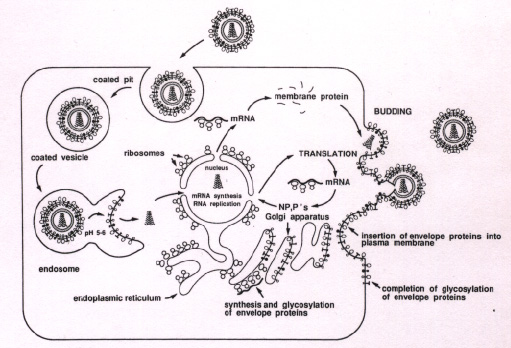Replication
 Overview of Influenza
Replication
Overview of Influenza
Replication
The influenza virus has a negative sense RNA genome. In order to
replicate, this means that the virus must first produce positive sense
mRNA in order to produce necessary enzymes. Once the enzymes are
translated, replication can take place. Positive sense cRNA is then made
from the original negative sense RNA, using the enzymes. Negative sense
RNA progeny are then made from the positive sense cRNA. The final viral
progeny eventually bud from the host cell, ready to infect other cells.
 Influenza Replication in Greater
Detail
Influenza Replication in Greater
Detail
The influenza virus enters the host cell by having its hemagglutinin bind
to the sialic acid found on glycoproteins or glycolipid receptors of the
host. The cell then endocytoses the virus. In the acidic environment of
the endosomes, the virus changes shape and fuses its envelope with the
endosomal membrane. This is followed by a signal to release the virus
nucleocapsid into the host cytoplasm. From there, the nucleocapsid
travels to the host nucleus.
In the host nucleus, the virus does primary transcription to produce
necessary proteins for replication. The primary transcription involves
what is known as "cap snatching." What this means is that the viral
endonuclease (PB2) cuts the 5' methylguanosine cap as well as ten to
thirteen nucleotides from the RNA. This is then used as the primer for
the transcription of the protein PB1, a viral transcriptase. In influenza
A and B, ten proteins result from the translation of the eight segments of
the genome, including hemagglutinin, neuraminidase, PB1, PB2,
nucleoprotein, another RNA polymerase complex, two matrix proteins, and
two NS proteins.
Once the initial proteins are made, then eight complementary positive
sense RNA strands are made from the eight negative sense RNA segments (at
least in influenza A and B. . . influenza C has seven segments). These
lack the 5' capped primer, as well as the 3' poly (A) tail found in the
mRNA. From this cRNA, a negative sense RNA is produced. Various proteins
then help this negative sense RNA exit the nucleus and into the cytoplasm
of the host.
In the meanwhile, in the cytoplasm, the hemagglutinin and neuraminidase
have undergone glycosylation, polymerization, and acylation. The
hemagglutinin, neuraminidase, and the matrix protein two (M2) all travel
together to the plasma membrane. There the proteins meet with the other
matrix protein (M1), and begin the budding process. At least eight RNA
segments come to the site (the mechanism is not completely known), and the
virus buds. The neuraminidase finally destroys the sialic acid receptors
on the membrane, thus allowing the virus to leave the cell.

From Robert A. Lamb and Robert M. Krug's "Orthomyxoviridae:
The Viruses and Their Replication," in Fields Virology, Lippincott-Raven
Publishers. 1996. p 1370.
Return to The Flu Family! Page
 Overview of Influenza
Replication
Overview of Influenza
Replication Overview of Influenza
Replication
Overview of Influenza
Replication Influenza Replication in Greater
Detail
Influenza Replication in Greater
Detail